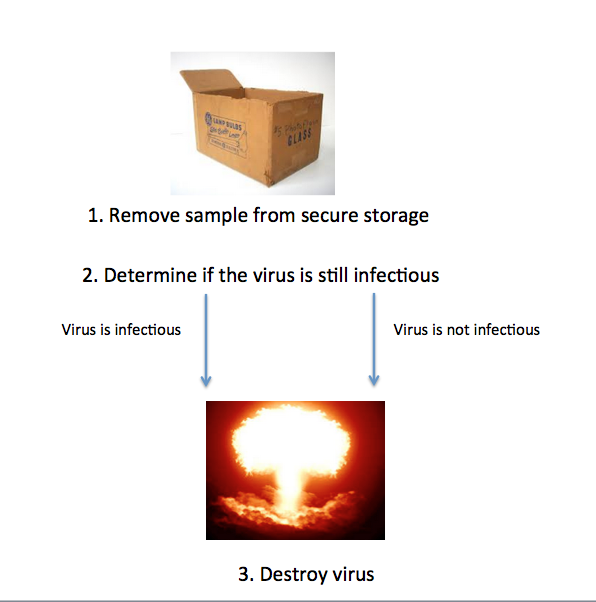While the TSA is strip-searching 95-year old women in wheelchairs, a janitor tripped over a box of smallpox samples that someone left in an old Budweiser cooler in some closet.
OK, this may not be strictly accurate. It could have been Bud Lite. And it wasn't really a janitor, but it really doesn't makes much difference in the grand scheme of things.
What really happened is that a bunch of sealed vials of the smallpox virus—possibly the most deadly pathogen ever—were discovered in a cardboard box in storage room, unsecured and unlocked. This is not good.
What makes this incident even more ironic is that about two months ago, the ongoing debate about whether to destroy the "two remaining samples" of the deadly virus resurfaced. Forgive me for being presumptive, but I think this debate needs to be put on hold until we make sure that there aren't more vials sitting around in a birdcage in Cleveland or a bowling alley in Brooklyn.
At least we are getting good advice. Michael Osterholm, director of the Center for Infectious Disease Research and Policy at the University of Minnesota, called the incident "a reminder to look at every freezer you have now just in case."
Yep, that's really helpful. I'm gonna take a pass on this one, since there are probably things in my freezer that are more dangerous than smallpox. Plus, the samples weren't even found in a freezer. They were in a chilly storage room—for about 50 years.
Some of the science is also interesting. For example, people seemed to be concerned whether the virus was alive or dead. The answer is neither. Viruses aren't alive in the first place. And even more puzzling was the decision to test the samples to see if the viruses were viable—capable of infecting cells.
The flowchart below highlights my doubts about doing this.

Perhaps it's because my days in virology research are behind me, but I don't get step #2 at all. What exactly is to be gained by opening the damn things up and testing them? It's too late anyhow. They've already been opened.
Another scientific jaw dropper: Part of the confusion apparently arose from the vials being labeled "variola" instead of "smallpox." OK- these vials were not found in Burger King.
They were found in an FDA lab located on a National Institutes of Health research campus in Bethesda, Maryland. Helooooooo? If you don't know that variola is simply another name for smallpox, perhaps a research job at the FDA wasn't such a great career move.
If you're concerned whether these government agencies are now on top of things, the following may or may not be helpful: FDA spokeswoman Jennifer Rodriguez said “We are carefully examining our policies and procedures regarding the security of our laboratories and storage of biologic specimens. We will ensure the implementation of a corrective action plan to ensure that our biological specimens are inventoried and properly secured.” Just in time.
Of course, this is not an isolated incident. You would have to live in the Bat Cave not to have heard about a similarly inept occurrence less than a month ago when 84 people were exposed to anthrax because of a nearly-superhuman screw up at the CDC's high security Bioterror Rapid Response and Advanced Technology laboratory in Atlanta.
Scientists there were investigating different method of killing the bug. Following the experiments, the "dead" bacteria were checked to make sure they were really dead by using a standard technique in bacteriology—putting the samples on an agar plate to make sure nothing grew.
According to Dr. Paul Meechan, environmental health and safety compliance office at the the director of the Center for Disease Control and Prevention (CDC) "They waited 24 hours. "They took a look at the plate, and they didn't see any new growth. At that point, they assumed the material was safe."
Well, this didn't work out all that well. In a rare case of two wrongs making a right, one of the agar plates was mistakenly left in the incubator for a week. Fortunately, in this case dumb was bailed out by dumb luck. As they were preparing to throw out the agar plates, some of the scientists noticed that something was growing on one of the plates. Take a wild guess what this was.
Meanwhile, the "dead" samples had already been shipped to two lower security CDC labs— not equipped to handle live anthrax— where scientists were investigating new methods to more rapidly detect the presence of the bacteria in the event of another terrorist attack. This is where the exposures took place.Imagine what might have happened if someone didn't notice that one plate: Live anthrax would have been disposed of, and ended up, in some unknown location—maybe my freezer—and the scientists in the other two labs would have probably discovered that something was wrong only after they began doing a Linda Blair.
And if this weren't bad enough, the anthrax being used was the same deadly strain that was used in the 2001 terrorist attacks.
This would almost be funny if it weren't so serious. Perversely, it is possible that the greatest threat of bioterrorism is coming from our own government. That should make you sleep well tonight.
And keep in mind that the ebola outbreak in Uganda—the worst on record, with a 90 percent mortality rate— could be one plane trip from ending up here. Or maybe the bigger risk is from a CDC lab where a bottle of it is sitting in the recycling bin next to an empty can of Dr. Pepper.
Perhaps the following is unfair, but I'm blaming it on that chicken salad sandwich I once ate in a CDC cafeteria.





Comments